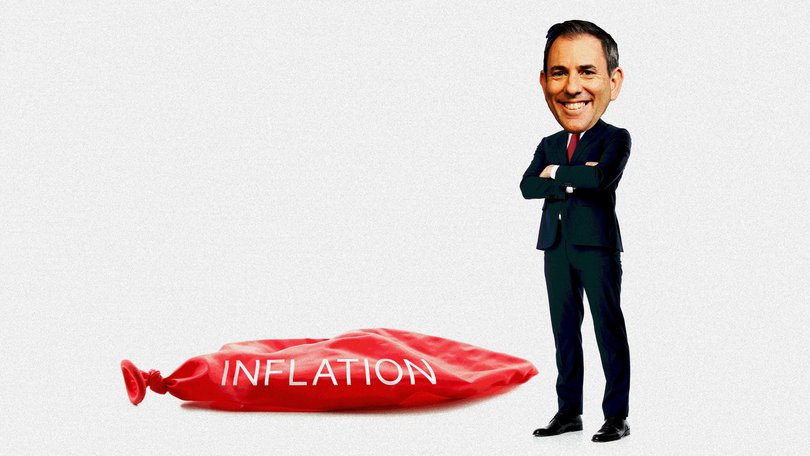JACKSON HEWETT: Australian inflation update, fading CPI makes rate cut a shoo-in

Any nervousness the Reserve Bank felt at its last rates meeting should be laid to rest.
Earlier this month, six of the nine members of the interest setting advisory board opted to keep rates on hold, citing the need for a clearer picture on inflation based on quarterly data.
Today they got it.
Sign up to The Nightly's newsletters.
Get the first look at the digital newspaper, curated daily stories and breaking headlines delivered to your inbox.
By continuing you agree to our Terms and Privacy Policy.In the June quarter, inflation continued to fall in line with the Bank’s forecast and is now the lowest it has been since March 2021.
Treasurer Jim Chalmers as good as declared it mission accomplished.
“These are outstanding numbers,” Dr Chalmers told Sky News.
“The fight against inflation has been the defining challenge in our economy for some years now, even before we came to office. When we came to the office, inflation was multiples of what it is now, and it was absolutely galloping.
“What Australians have been able to do in the last few years is nothing short of remarkable, because we’ve got inflation down without paying for it with substantially higher unemployment.”
Those “outstanding numbers” showed headline inflation rose by 0.7 per cent in the June quarter to 2.1 per cent, down from 2.4 per cent in March.
Trimmed mean inflation, which strips out volatile items like fuel and food, was 2.7 per cent, down from 2.9 per cent.
The figures were helped by big falls in the cost of fuel - down 10 per cent in a year - as oil prices fall on softening global demand.
It’s not all beer and skittles on the inflation front however. Food and non-alcoholic beverages were up 1 per cent in the quarter, thanks to a 4.3 per cent hike in the cost of fruit and vegetables. The price of eggs has soared almost 20 per cent in a year as bird flu outbreaks threaten supply.
With electricity rebates rolling off, energy costs remain elevated, up 8.1 per cent. That helped push overall housing inflation up by 1.2 per cent in the quarter.
Rental and insurance inflation is slowing, but still causing pain - up 4.5 per cent and 3.9 per cent annually. The good news is the trajectory is down.
“This is the lowest Services annual inflation in three years and continues to reflect easing inflation for rents and insurance,” ABS head of prices statistics Michelle Marquardt said.
Deloitte Access Economics partner Stephen Smith said policy settings must now “shift from containing inflation to stimulating growth.”
That is particularly urgent as Australia continues to sweat on the impact of a trade deal with the US, and a likely slowdown in the global economy as a minimum 15 per cent tariff looms for most nations.
“The Bank knows its monetary policy settings are restricting growth. This is hard to justify given ongoing global economic volatility and the continued sluggishness of our own domestic economy,” Mr Smith said.
The question hanging over the RBA now is whether the Bank will pivot its position to go harder on rate cuts.
RSM Australia economist Devika Shivadekar thinks the cautious approach that has served the Bank so well will continue.
“We expect the Board will continue to move cautiously for the rest of the year. Governor Michele Bullock has emphasised that the RBA’s approach will remain “measured and gradual”, particularly as Australia did not hike rates as aggressively during the 2022–23 inflation peak,” Ms Shivadekar said.
If the Bank does finally pull the trigger for the third time this year, it should restart the firing gun on a gradual reduction in rates to 2.85 per cent, according to Westpac chief economist and former Reserve Bank head of economics, Luci Ellis.
Westpac expects a 0.25 per cent rate cut to 3.6 per cent in August, with further cuts in November, February and May 2026.
That’s because other data points are starting to show signs of strain in the economy, particularly employment, which had been “tight” in the RBA’s eyes. In June, the unemployment rate ticked up and job growth slowed, while new jobs were mostly part-time. Job mobility dropped to its lowest level in a decade, suggesting workers were nervous about risking a leap to new positions.
“We suspect that today’s data will come as something of a relief to the RBA. By cementing the inflation case to cut, it removes any awkwardness around the signs of a renewed softening in the labour market, which would otherwise conflict with its response to inflation risks,” Ms Ellis said.
But can a further cut in rates do much more to lift the country out of its torpor?
Warren Hogan, chief economic adviser to Judo Bank, believes the biggest impact from cuts, or hikes for that matter, happens at the extremes.
He said when rates are at or close to the neutral level - that is, when interest levels are neither contractionary or expansionary - it is business conditions that determine the strength of the economy. And currentl,y business investment was yet to respond to lower rates as business margins were still taking a hit from budget-strained consumers.
“It’s this slowdown in profitability that is the headwind for greater investment,” he said.
Confidence to invest has been identified as a key issue to be discussed at the Treasurer’s upcoming economic reform roundtable. The most recent ABS statistics show that total business capital investment has stalled, down 0.1 per cent in the March quarter, and down 1.3 per cent for equipment, plant and machinery.
“In a world where business needs to be investing, whether in new processes, capital equipment or artificial intelligence, we don’t need a business investment strike right now,” Mr Hogan said.
“We are facing into a big shift from labour abundance to labour shortage, and the country needs to make a leap to new technology, and there are a whole raft of those things making that big leap difficult.”
The Reserve Bank has consistently called out the lack of unit labour productivity as a reason why it is concerned about cutting rates further, prompting a number of submissions to the economic reform round table calling for a significant boost in investment in labour-enhancing technology.
In its submission, consulting firm McKinsey argues that living standards in Australia have declined faster than in any other developed economy due to declining per capita GDP growth accompanied by higher consumer prices, mortgage interest repayments, and income taxes. Falling productivity is the main cause of that GDP per capita decline.
McKinsey estimates 70 per cent of the productivity fall can be attributed to private capital expenditure falling below the recession levels of the 1990s. To restore Australia’s fortunes, they suggest an additional $130 billion in private sector investment annually.
A few interest rate cuts between now and May is not going to achieve that. Instead, McKinsey recommends slashing government regulation, unleashing the power of Australia’s conservative finance sector and pushing down energy costs. It also suggests that Australia has too many protected non-productive firms, when it is large companies that act as productivity champions.
Australians’ obsession with property surely should also take the blame. As interest rate cuts put a renewed trajectory under house prices, risk capital is not only locked up in unproductive dwellings, but risk-averse workers are also disincentivised to move to more productive employment.
“We have globally leading levels of household debt,” Mr Hogan said.
“When you are locked into debt for a long time you value job stability and security. That’s contributing to our record low job mobility, and that’s not going to help the country in this next wave of economic change.”
The RBA will hopefully pull a lever to help mortgage holders on 12 August, but it is the roundtable on 19 August that will have a far greater impact on long-term prosperity. That’s if participants have the courage to act.

